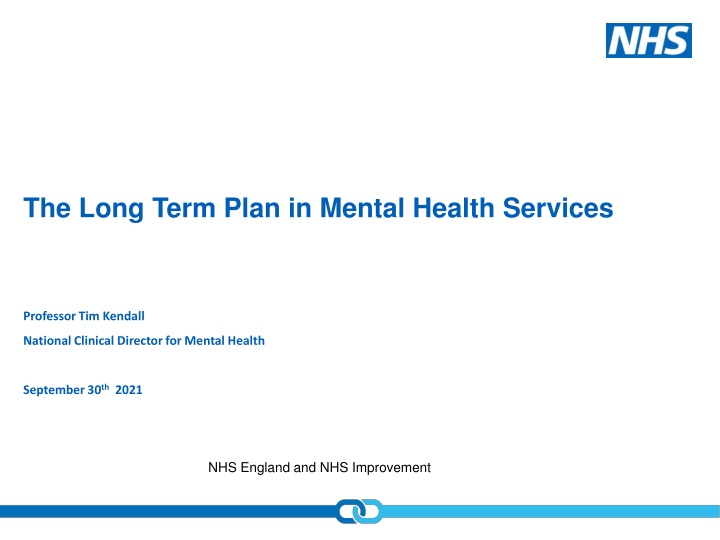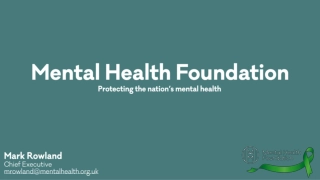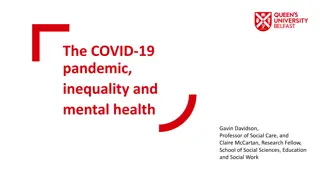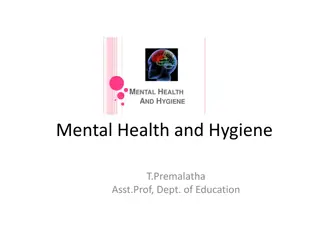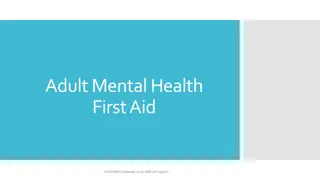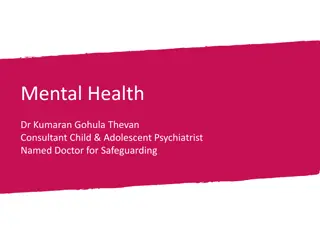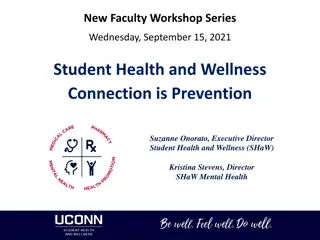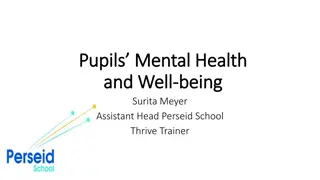The Long Term Plan in Mental Health Services: Key Ambitions and Achievements
Professor Tim Kendall, National Clinical Director for Mental Health, outlined key ambitions for mental health services in the NHS Long Term Plan by 2023/24. These include increased access to specialist perinatal mental health services, school-based support teams, and NICE-approved IAPT services. The plan aims to enhance community support for those with severe mental illness, improve crisis support, and reduce lengths of stay in facilities. Additionally, efforts will focus on tackling rough sleeping, gambling problems, and expanding suicide reduction programs. The Five Year Forward View for Mental Health has already made significant progress in expanding access and quality of mental health care, with achievements like increased access to talking therapies, crisis lines, perinatal services, and staff mental health support.
Download Presentation

Please find below an Image/Link to download the presentation.
The content on the website is provided AS IS for your information and personal use only. It may not be sold, licensed, or shared on other websites without obtaining consent from the author.If you encounter any issues during the download, it is possible that the publisher has removed the file from their server.
You are allowed to download the files provided on this website for personal or commercial use, subject to the condition that they are used lawfully. All files are the property of their respective owners.
The content on the website is provided AS IS for your information and personal use only. It may not be sold, licensed, or shared on other websites without obtaining consent from the author.
E N D
Presentation Transcript
The Long Term Plan in Mental Health Services Professor Tim Kendall National Clinical Director for Mental Health September 30th 2021 NHS England and NHS Improvement
Mental Health in the NHS Long Term Plan: Key Ambitions at a Glance (by 2023/24) 24,000 additional women will access specialist perinatal mental health services. The period of care will be extended from 12 months to 24 months post-birth 345,000 more CYP will access help via NHS funded mental health services and school or college-based Mental Health Support Teams Provide better community mental health support to 370,000 people with SMI via new and integrated models of primary and community care Anyone experiencing mental health crisis will be able to call NHS 111 and have 24/7 access to the mental health support they need 380,000 more people will access NICE-approved IAPT services each year Reduced length of stay in units with a long length of stay to the national average of 32 days Ensure that the parts of England most affected by rough sleeping will have better access to specialist homelessness NHS mental health support Expand geographical coverage of NHS services for people with serious gambling problems Expand the existing suicide reduction programme to all STPs in the country
Five Year Forward View for Mental Health achievements The achievements of the Five Year Forward View for Mental Health form a steady foundation for the growth in access and quality promised in the Long Term Plan. By 2023/24, an additional 2 million people will receive mental health care. Achievements during the pandemic COVID-19 became the catalyst for existing commitments to be realised sooner than planned, and to establish new services in response to patient need which are demonstrating ongoing value: The NHS achieved a CYP mental health services access rate of 39.6% in 2020/21, exceeding the 35% target. Increasing access to talking therapies with 1.17m people starting treatment in 2019/20. Rapid roll-out of 24/7 all age mental health crisis lines, supporting a quarter of a million people a month. Establishing specialist community perinatal mental health services in all parts of England, which saw 30,700 people in 2020/21. 70 new or expanded CYP eating disorder teams now cover all parts of England. 10,700 patients started treatment in 2020/21, compared to 8,000 in 2019/20. Rapid shift to remote working, providing care more flexibly and overcoming access barriers. 73% of people experiencing their first episode of psychosis accessed specialist care within two weeks of referral, against a target of 60%. Mental health and wellbeing offer for NHS staff impacted by the pandemic, underpinned by 40 new hubs across England. Dedicated NHS mental health support teams in place at 3,000 schools across the country. Published first Advancing Mental Health Equalities Strategy.
Going further Support IAPT services to achieve 2021/22 access target of 1.6m people and assist recovery for people disproportionately impacted by COVID-19. Increase number of Mental Health Support Teams in schools from 59 in March 2020 to around 400 by April 2023. Additional 500m* investment in mental health in 2021/22 will enable us to Support an extra 15,000 people with serious mental health problems to recover at home rather than in hospital. Investment in post- discharge support to reduce length of stay, 6 and 12-hour waits in A&E and inappropriate out of area placements. Support services to work with communities experiencing differential outcomes and experiences. Increase the size of the mental health workforce to deliver our ambitions and improve equality and diversity. *This additional 500m investment in mental health was announced by the Chancellor in November 2020.
Through the Long Term Plan, we have committed to improving care for adults and older adults with severe mental illnesses At least 975m extra per year 370,000 Adults and older adults who have severe mental illnesses will be supported to access new and integrated models of primary and community mental health care per year by 2023/24, so that they will have greater choice and control over their care, and be supported to live well in their communities. Will be invested into community mental health services per year by 2023/24 to achieve this vision.
The Long Term Plan includes ambitious targets for community mental health New funding for community mental health will flow to local systems, to invest in recruiting new members of the community mental health workforce and commissioning new VCSE services. We are aiming to provide better care to people already receiving mental health support in the community, and increase access to these services. Key deliverables in the Long Term Plan by 2023/24 Dedicated focus Core model Physical health IPS EIP Improving access and treatment for adults and older adults with a diagnosis of personality disorder', in need of mental health rehabilitation and eating disorders, contributing to 370k minimum access number by 23/24 Maintaining the 60% Early Intervention in Psychosis access standard and ensuring 95% of services achieve Level 3 NICE concordance A new, inclusive generic community-based offer based on redesigning community mental health services in and around Primary Care Network, contributing to 370k minimum access number by 23/24 Increasing the number of people with SMI receiving a comprehensive physical health check to a total of 390,000 people per year Supporting a total of 55,000 people a year to participate in the Individual Placement and Support programme
Smoking and mental health Smoking tobacco is the top modifiable risk factor that drives deaths and disability. Smoking rates for people with a long-term mental health condition are 26.8% (2018/19) compared to 13.9% in the general population (Gov, 2020; ONS, 2020). The Mental Health Smoking Partnership s summary of evidence highlight that among people (MHSP, 2017): with a common mental health condition (anxiety and/or depression) the smoking rate is 34%. For those living in poverty this rises to 46%, with a SMI the smoking rate is around 40%, with probable psychosis having a smoking rate of up to 60%, and in mental health units, smoking rates can rise to 70%. Analysis has shown 85% of the observed health inequalities between socioeconomic groups could be attributed to smoking (Gruer, 2009). Smoking is the biggest driver of the life expectancy gap for people with severe mental illness, who on average die 10-20 years earlier than the general population (PHE, 2020). 7 | 7 |
Tackling tobacco dependence People with MH conditions smoke at higher rates and are more heavily addicted. The Royal College of Physicians estimate that 1/3 of adult tobacco consumption is by people with a mental health condition (RCP, 2018). People with mental health conditions have an equal desire to stop smoking as those without (Situ et al, 2009; Brose, 2020). Smoking cessation interventions are both tolerable and effective for people with mental health conditions (Roberts et al, 2016; Benham and Gilbody, 2010). Stopping smoking breaks the cycle of dependence and withdrawal; improving physical health and having a beneficial impact on long-term levels of depression and anxiety (Taylor, 2014). Stopping smoking can also decrease the incidence of physical assaults on staff (RCP, 2018;UK Medicines Information, 2020; Robson, 2017). Despite this, the decline in smoking prevalence is slower in those with a mental health condition. 8 | 8 |
NHS Long Term Plan The LTP set out the following commitments relating to smoking and mental health: o By 2023/24, all those admitted to hospital who smoke will be offered NHS-funded tobacco dependence treatment services this includes mental health inpatients. o A new universal smoking cessation offer will also be made available as part of specialist mental health and learning disability services in the community. The recommended intervention sets out the expectations for tobacco dependence treatment services, which include: o smoking status is recorded for every patient admitted to hospital; o they are opt-out referred for an in-house discussion with an appropriately trained tobacco dependence adviser; o they have early access to appropriate pharmacotherapy, and; o are able to agree a personalised plan to support them to quit smoking tobacco both whilst in contact with NHS services and beyond. These services will be delivered in addition to, and in conjunction with (where relevant), local authority commissioned Stop Smoking Services. 9 | 9 |
